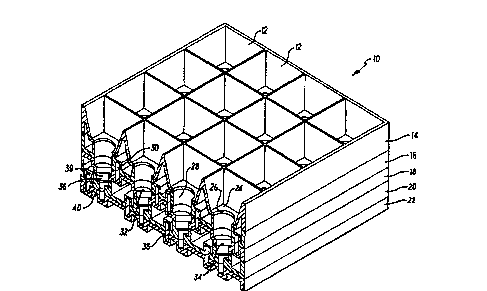Une partie des informations de ce site Web a été fournie par des sources externes. Le gouvernement du Canada n'assume aucune responsabilité concernant la précision, l'actualité ou la fiabilité des informations fournies par les sources externes. Les utilisateurs qui désirent employer cette information devraient consulter directement la source des informations. Le contenu fourni par les sources externes n'est pas assujetti aux exigences sur les langues officielles, la protection des renseignements personnels et l'accessibilité.
L'apparition de différences dans le texte et l'image des Revendications et de l'Abrégé dépend du moment auquel le document est publié. Les textes des Revendications et de l'Abrégé sont affichés :
| (12) Demande de brevet: | (11) CA 2184080 |
|---|---|
| (54) Titre français: | ANTENNES HYPERFREQUENCE |
| (54) Titre anglais: | MICROWAVE ANTENNAS |
| Statut: | Réputée abandonnée et au-delà du délai pour le rétablissement - en attente de la réponse à l’avis de communication rejetée |
| (51) Classification internationale des brevets (CIB): |
|
|---|---|
| (72) Inventeurs : |
|
| (73) Titulaires : |
|
| (71) Demandeurs : | |
| (74) Agent: | SMART & BIGGAR LP |
| (74) Co-agent: | |
| (45) Délivré: | |
| (86) Date de dépôt PCT: | 1995-02-24 |
| (87) Mise à la disponibilité du public: | 1995-08-31 |
| Requête d'examen: | 2002-02-21 |
| Licence disponible: | S.O. |
| Cédé au domaine public: | S.O. |
| (25) Langue des documents déposés: | Anglais |
| Traité de coopération en matière de brevets (PCT): | Oui |
|---|---|
| (86) Numéro de la demande PCT: | PCT/GB1995/000398 |
| (87) Numéro de publication internationale PCT: | WO 1995023440 |
| (85) Entrée nationale: | 1996-08-23 |
| (30) Données de priorité de la demande: | |||||||||
|---|---|---|---|---|---|---|---|---|---|
|
Selon l'invention, on forme une antenne hyperfréquence (10) à partir d'une pile d'éléments (14-22) généralement plans formant un réseau d'éléments en forme de cornets communiquant avec les guides d'ondes (38). Ces éléments (14-22) sont en plastique métallisé et présentent chacun une épaisseur globale constituée par une membrane d'épaisseur relativement faible, dotée (généralement par formation sous vide) d'une configuration ondulée.
A microwave antenna (10) is formed from a stack of generally planar elements (14-22) forming an array of horns (12) communicating
with waveguides (38). The generally planar elements (14-22) are of metallised plastics. Each of these elements (14-22) has a given overall
thickness which is constituted by a membrane of relatively small thickness formed (typically by vacuum forming) into a corrugated shape.
Note : Les revendications sont présentées dans la langue officielle dans laquelle elles ont été soumises.
Note : Les descriptions sont présentées dans la langue officielle dans laquelle elles ont été soumises.

2024-08-01 : Dans le cadre de la transition vers les Brevets de nouvelle génération (BNG), la base de données sur les brevets canadiens (BDBC) contient désormais un Historique d'événement plus détaillé, qui reproduit le Journal des événements de notre nouvelle solution interne.
Veuillez noter que les événements débutant par « Inactive : » se réfèrent à des événements qui ne sont plus utilisés dans notre nouvelle solution interne.
Pour une meilleure compréhension de l'état de la demande ou brevet qui figure sur cette page, la rubrique Mise en garde , et les descriptions de Brevet , Historique d'événement , Taxes périodiques et Historique des paiements devraient être consultées.
| Description | Date |
|---|---|
| Inactive : CIB de MCD | 2006-03-12 |
| Demande non rétablie avant l'échéance | 2005-02-24 |
| Le délai pour l'annulation est expiré | 2005-02-24 |
| Inactive : Abandon. - Aucune rép dem par.30(2) Règles | 2004-02-26 |
| Réputée abandonnée - omission de répondre à un avis sur les taxes pour le maintien en état | 2004-02-24 |
| Inactive : Dem. de l'examinateur par.30(2) Règles | 2003-08-26 |
| Lettre envoyée | 2002-04-19 |
| Inactive : Dem. traitée sur TS dès date d'ent. journal | 2002-04-19 |
| Inactive : Renseign. sur l'état - Complets dès date d'ent. journ. | 2002-04-19 |
| Exigences pour une requête d'examen - jugée conforme | 2002-02-21 |
| Toutes les exigences pour l'examen - jugée conforme | 2002-02-21 |
| Inactive : Grandeur de l'entité changée | 2002-02-12 |
| Modification reçue - modification volontaire | 1996-11-20 |
| Demande publiée (accessible au public) | 1995-08-31 |
| Date d'abandonnement | Raison | Date de rétablissement |
|---|---|---|
| 2004-02-24 |
Le dernier paiement a été reçu le
Avis : Si le paiement en totalité n'a pas été reçu au plus tard à la date indiquée, une taxe supplémentaire peut être imposée, soit une des taxes suivantes :
Veuillez vous référer à la page web des taxes sur les brevets de l'OPIC pour voir tous les montants actuels des taxes.
| Type de taxes | Anniversaire | Échéance | Date payée |
|---|---|---|---|
| TM (demande, 3e anniv.) - petite | 03 | 1998-02-24 | 1998-02-09 |
| TM (demande, 4e anniv.) - petite | 04 | 1999-02-24 | 1999-02-02 |
| TM (demande, 5e anniv.) - petite | 05 | 2000-02-24 | 2000-02-21 |
| TM (demande, 6e anniv.) - petite | 06 | 2001-02-26 | 2001-01-31 |
| TM (demande, 7e anniv.) - générale | 07 | 2002-02-25 | 2002-02-04 |
| Requête d'examen - générale | 2002-02-21 | ||
| TM (demande, 8e anniv.) - générale | 08 | 2003-02-24 | 2003-02-06 |
| TM (demande, 2e anniv.) - petite | 02 | 1997-02-24 |
Les titulaires actuels et antérieures au dossier sont affichés en ordre alphabétique.
| Titulaires actuels au dossier |
|---|
| FORTEL TECHNOLOGY LIMITED |
| Titulaires antérieures au dossier |
|---|
| JOHN LOUIS FREDERICK CHARLES COLLINS |